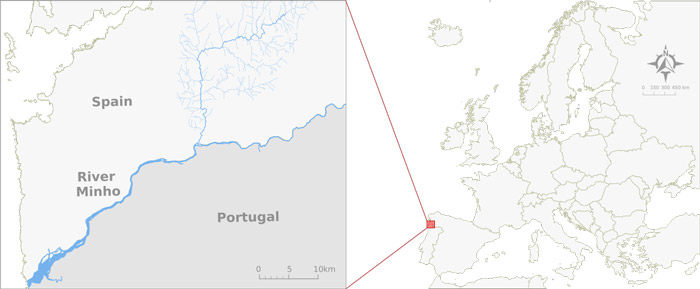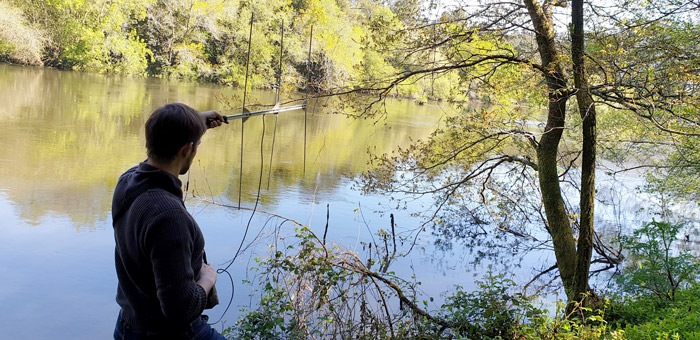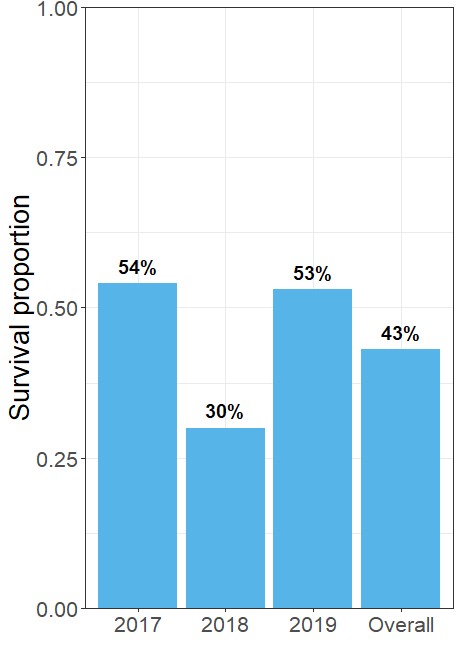The River Minho, at the border between Portugal and Spain, represents the southern distribution limit for Atlantic salmon in Europe (figure 1). Despite being critically endangered, relatively little is known about the Atlantic salmon inhabiting this river, particularly about behaviour and survival during migration.

Figure 1: The River Minho is located in the Iberian Peninsula and represents a natural border between Portugal and Spain.
Scientists from the SMOLTRACK project and local authorities set out to investigate this by equipping Atlantic salmon juveniles with transmitters and recording their migration towards the sea (figure 2).
The results show low survival and hence management actions aiming at increasing this survival are likely to improve the conservation status of the Atlantic salmon.
As such, it is vital that as many juveniles as possible reach the sea and survive to adulthood. Knowledge of potential survival bottlenecks is paramount to ensure the long-term survival of this important population.

Figure 2. Radio tracking of tagged smolts in River Minho.
The study showed that less than half of the tracked smolts survived the migration to the sea (figure 3), with smaller smolts showing the lowest survival. Multiple groups of predators appear to be responsible for at least part of the losses (including birds, mammals, and larger fish).
Atlantic salmon is one of the world’s most iconic migratory species. Despite being born in rivers, most Atlantic salmon migrate to the sea to feed and grow. This migration period is particularly challenging, as the fish must cross unknown territories, meet new predators and prepare for life at sea. The Atlantic salmon population of the River Minho is very important on a larger scale because it likely has local adaptations to warmer climate, which may prove essential to ensure the species survival in future climate scenarios. The presence of a large dam just 80 km up this 310 km river severely limits the spawning grounds available to Atlantic salmon in this region.
However, probable causes of death could only be determined for part of the mortalities recorded and, as such, other sources of mortality may be present. Population growth of predator species such as great cormorants or American mink is likely putting an extra pressure on this population, hampering its recovery to sustainable levels.

Figure 3. The percentage of smolts that reached the end of the study area
The recorded low survival indicates that there is room for focused management actions aiming to increase the number of smolts that reach the sea. This would have direct consequences on the number of returning adults, which would likely be visible (and measurable) within one to three years. As such, it could quickly lead to an improvement in the conservation status of the population. Portugal and Spain are already working towards the recovery of migratory species in River Minho (e.g. through the project MigraMinho); this cooperation must continue to ensure that agreed management actions lead to an actual improvement in conservation status of this important Atlantic salmon population.
Access the paper here
This study is part of the SMOLTRACK project (www.smoltrack.eu). This project is an European collaboration of international lead researchers in Atlantic salmon ecology and management. This project aims to aid in sharing knowledge and best practices for the recovery of Atlantic salmon, with the goal of informing future salmon management and conservation work on an EU level.
Contact: Hugo Flávio, Pablo Caballero, Niels Jepsen and Kim Aarestrup